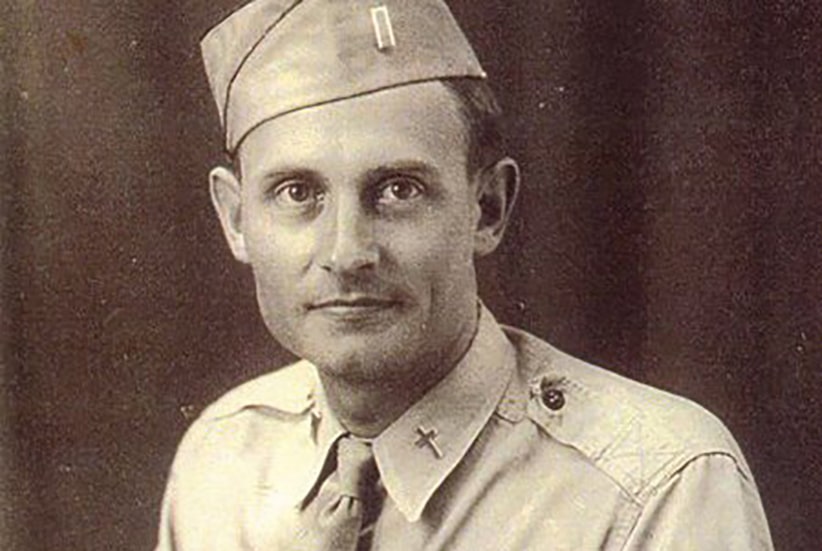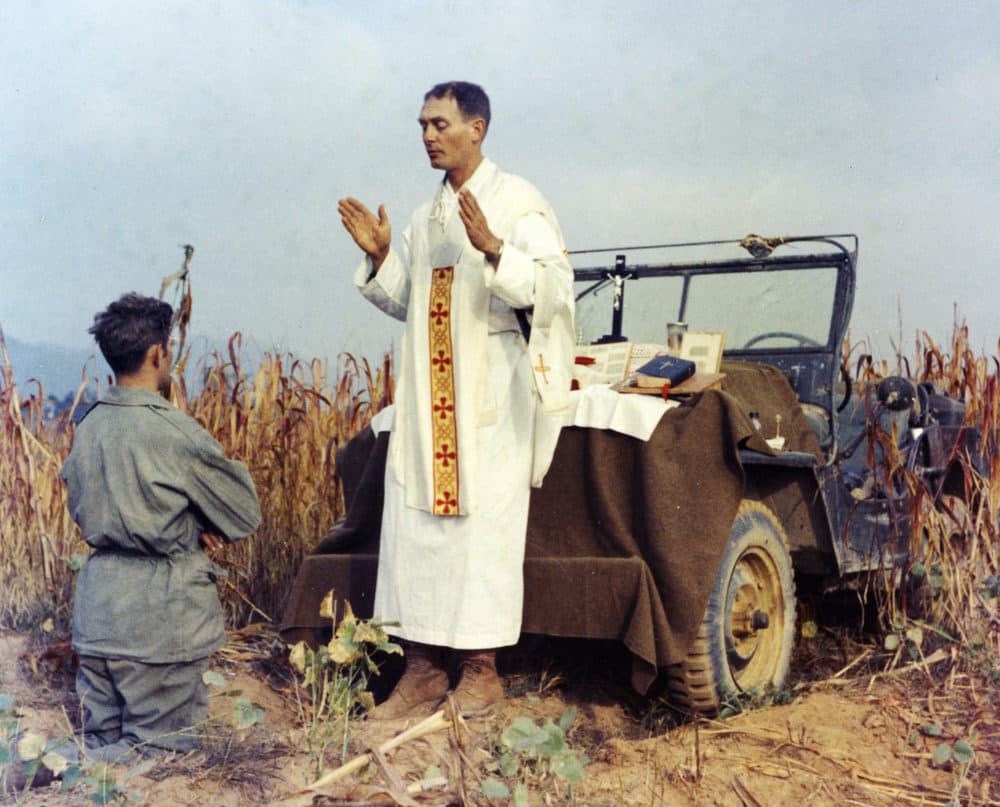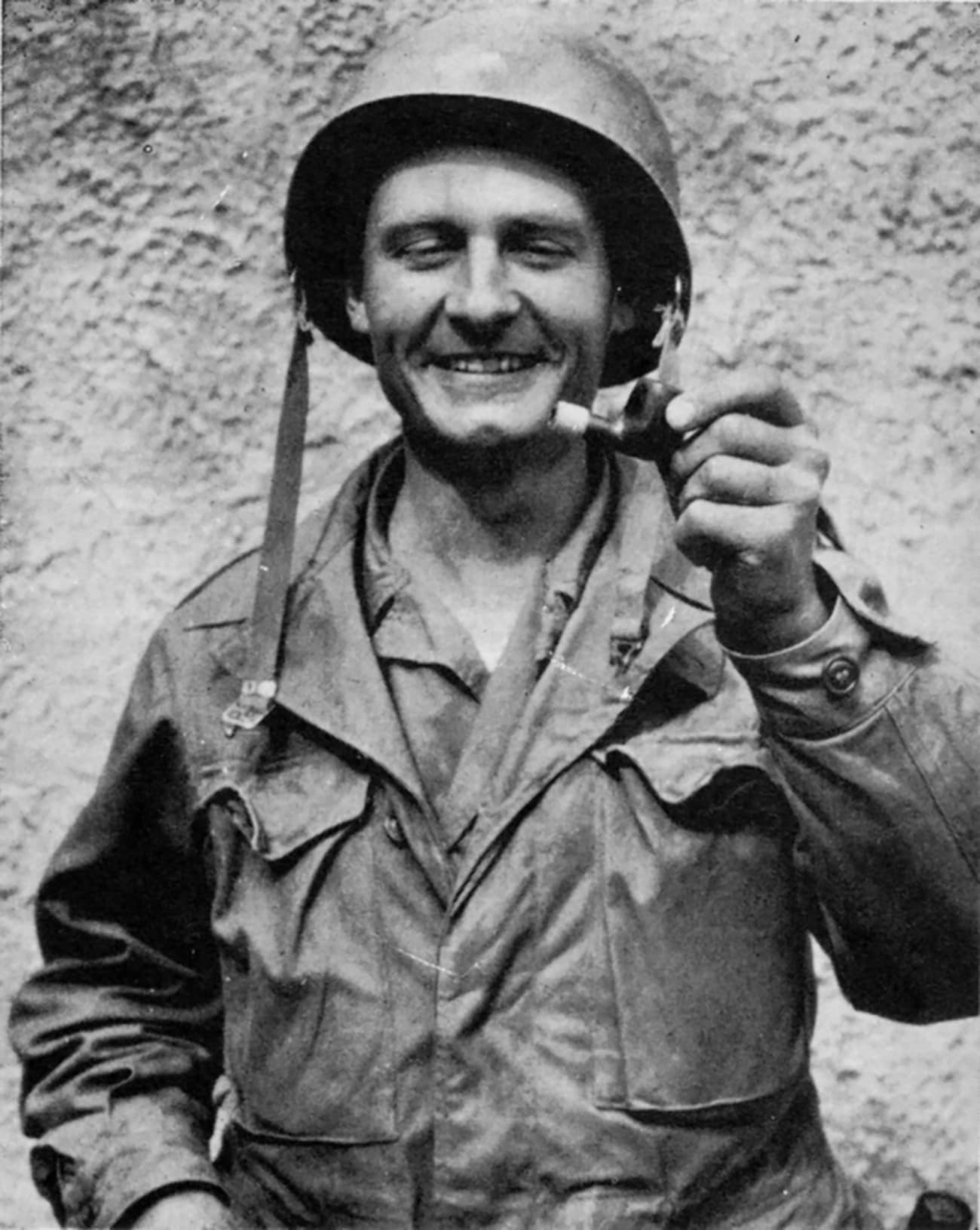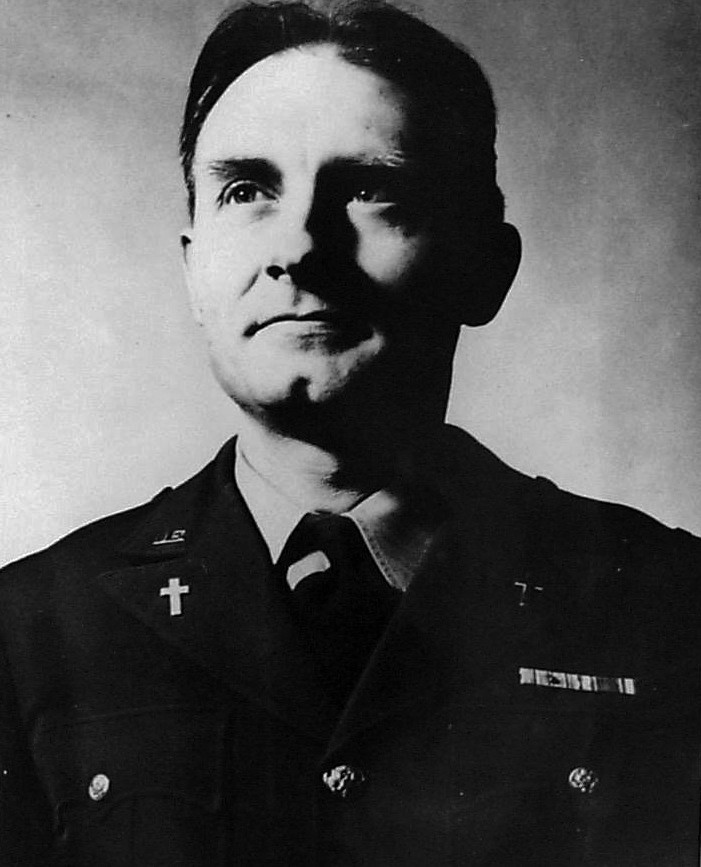The Steadfast Bravery of Father Emil Kapaun


Captain Emil Joseph Kapaun was a U.S. Army chaplain who received the Medal of Honor, for his heroic actions during the Korean War. He is the ninth chaplain Medal of Honor recipient. He was born April 20, 1916 on a small farm near Witchita, Kansas to a Catholic Czech family. He was down-to-earth and had a sense of humor: he joked that he wanted low grades to avoid being a leader. Shortly after seminary, Father Emil joined the U.S. Army Chaplains Corps four years later in 1944, as he felt pulled to administer to the soldiers fighting overseas. His first assignment during the tail end of World War II was serving in Burma and India. He would often travel by jeep for thousands of miles to meet soldiers. At the end of WWII, he was promoted to the rank of captain and then joined 1st Calvary Division as a chaplain in occupied Japan.

North Korea invaded South Korea on June 25th, 1950. On July 18, the 1st Cavalry Division, along with Fr. Kapaun, made landfall on the Korean Peninsula to repel the invasion. Amidst skirmishes with the North Korean Army, Kapaun learned about a wounded soldier pinned down by enemy fire who was left behind in a 1st Calvary Division retreat. Fr. Kapaun and another evaded gunfire and saved the soldier’s life. Fr. Kapaun was awarded the Bronze Star Medal with a “V” device for valor for this action. After the Battle of Inchon, UN troops began pushing the North Korean troops northward. Over time, Fr. Kapaun became well-known serving the troops, rescuing wounded and dead men, and administering sacraments. He celebrated Mass on an improvised altar which he set up on the front end of his Jeep. Oftentimes he downplayed the danger that he was in, but once he wrote to a friend, “This fighting is nerve-wracking. It seems unreal.” This did not disrupt his fellow soldiers’ opinions of him. One of the troops who knew him wrote later, “To all… he was simply ‘Father,’ and each of them, when trouble came, drew courage and hope and strength from him…. He was a priest… of great piety, but there was nothing ethereal about him, nothing soft or unctuous or holier-than-thou. He wore his piety in his heart.”

Father Kapaun was awarded the Medal of Honor for his actions during the Battle of Unsan on November 1st and 2nd of 1950. As UN forces marched further north they were met with a surprised offensive from the Chinese Army. The first engagement with the Chinese Army happened near Unsan, North Korea. The 1st Cavalry Division arrived Oct. 30 as South Korean soldiers desperately fought Chinese troops. Waves of enemy forces (numbering nearly 20,000) swept over the 1st Cavalry Division near Unsan, and most of the division fell back to a line between the coast and the Taedong River valley. Fr. Kapaun’s unit, the 3rd Battalion, acted as a rear guard though. This battalion couldn’t break the Communist lines: they were trapped as their comrades fled.

Comrades testified that Father Kapaun remained by his own volition instead of trying to leave. He “decided to allow himself to be captured so that he could remain with the wounded Americans.” He would go from unit to unit to provide medical aid, encouragement, and spiritual comfort to the men. Fr. Kapaun also would run across the fields that were sometimes 100 yards outside American lines to drag men back. During the fight, he braved enemy fire and rescued nearly 40 men. Chaplain Kapaun somehow managed to negotiate with a wounded Chinese officer the safe surrender of some of the Americans. 600 of the 800 men in the 3rd Battalion who had arrived in Unsan had been killed or captured. The other 200 either escaped on their own or were saved through Kapaun’s negotiation. Shortly after his capture, Chaplain Kapaun saw that one of the Chinese soldiers was about to shoot a man named Sergeant First Class Herbert A. Miller. Sergeant First Class Miller was in a very weak state and was falling behind; the soldiers executed people who did this. To prevent Miller’s death, Fr. Kapaun pushed the enemy soldier to the ground and immediately began helping to carry Miller. Miller would then go on to survive the war; this is entirely thanks to Fr. Kapaun’s efforts. For all of the above listed efforts, Father Kapaun was posthumously awarded the Medal of Honor.

While the events after November 1st and 2nd are not commemorated in his Medal of Honor, they must be acknowledged. After days of marching, the surviving men were brought to a makeshift prison camp at Pyoktong. Life in the prison camp was horrific; up to 2 dozen men could die a day from disease, hunger, and extreme cold. Employing skills he acquired on the farm, he awoke before dawn would melt snow for clean water for the men to drink. He created basins out of metal sheeting to have containers for cleaning the clothes of the infirm and wounded. To help those suffering from starvation, Fr. Kapaun was the primary person who would steal food for the men to eat. Though it was forbidden, Fr. Kapaun led an Easter Mass in 1951. “Father saved our lives, really,” one camp survivor said, “he kept morale up; told us not to give up hope. Everyone who knew him idolized him in those moments.” After more than six months at the prison camp, Kapaun’s deteriorated health and malnutrition caused him to develop pneumonia, which he never recovered from. He died on May 23, 1951, after being carried off by enemy soldiers to a ‘hospital’ (where camp guards would send all dying men) where he succumbed to a blot clot and malnutrition.

A provision of the armistice, the remains of 1,868 Americans (including Kapaun’s) were returned to U.S. custody but none were able to be identified. The Army declared his remains non-recoverable in January 1956. These unidentified remains were interred at the National Memorial Cemetery of the Pacific in Honolulu, Hawaii. In 1993, Pope John Paul II declared Kapaun a Servant of God, the first stage toward canonizing someone as a saint. At a White House ceremony on April 11, 2013, President Barack Obama posthumously awarded Fr. Kapaun the Medal of Honor for extraordinary heroism and selflessness at the Battle of Unsan. In 2019, Fr. Kapaun’s remains were identified via mRNA testing and he was laid to rest on September 29, 2021, in his hometown of Wichita, Kansas.


Kapaun’s Medal of Honor citation can be found here and reads:
For conspicuous gallantry and intrepidity at the risk of his life above and beyond the call of duty while serving with the 3d Battalion, 8th Cavalry Regiment, 1st Cavalry Division during combat operations against an armed enemy at Unsan, Korea, from November 1-2, 1950. On November 1, as Chinese Communist Forces viciously attacked friendly elements, Chaplain Kapaun calmly walked through withering enemy fire in order to provide comfort and medical aid to his comrades and rescue friendly wounded from no-man’s land. Though the Americans successfully repelled the assault, they found themselves surrounded by the enemy. Facing annihilation, the able-bodied men were ordered to evacuate. However, Chaplain Kapaun, fully aware of his certain capture, elected to stay behind with the wounded. After the enemy succeeded in breaking through the defense in the early morning hours of November 2, Chaplain Kapaun continually made rounds, as hand-to-hand combat ensued. As Chinese Communist Forces approached the American position, Chaplain Kapaun noticed an injured Chinese officer amongst the wounded and convinced him to negotiate the safe surrender of the American Forces. Shortly after his capture, Chaplain Kapaun, with complete disregard for his personal safety and unwavering resolve, bravely pushed aside an enemy soldier preparing to execute Sergeant First Class Herbert A. Miller. Not only did Chaplain Kapaun’s gallantry save the life of Sergeant Miller, but also his unparalleled courage and leadership inspired all those present, including those who might have otherwise fled in panic, to remain and fight the enemy until captured. Chaplain Kapaun’s extraordinary heroism and selflessness, above and beyond the call of duty, are in keeping with the highest traditions of military service and reflect great credit upon himself, the 3d Battalion, 8th Cavalry Regiment, the 1st Cavalry Division, and the United States Army.
Bibliography
“1st CAVALRY DIVISION (THE FIRST TEAM) IN THE KOREAN WAR.” U.S. Army Center of Military History. Accessed May 16, 2023. https://history.army.mil/documents/Korea/1CD-KW-IP.html
Alyssa Murphy Alyssa Murphy is the Register’s Managing Editor of Digital Assets. Starting her career on the airwaves in San Francisco. “Father Emil Kapaun: 18 Things Every Catholic Should Know about This Heroic Priest.” NCR. Accessed May 16, 2023. https://www.ncregister.com/blog/father-emil-kapaun-18-things-every-catholic-should-know-about-this-heroic-priest.
Bunderson, Carl. “Heroic Korean War Priest Remembered by Prison-Mate.” Catholic News Agency, May 17, 2023. https://www.catholicnewsagency.com/news/26964/heroic-korean-war-priest-remembered-by-prison-mate.
“CBI Saint Father Emil J. Kapaun.” Father Emil J. Kapaun – CBI Saint. Accessed May 16, 2023. https://cbi-theater.com/kapaun/kapaun.html.
“Chaplain Accounted for from Korean War (Kapaun, e.).” Defense POW/MIA Accounting Agency, May 14, 2021. https://www.dpaa.mil/News-Stories/News-Releases/PressReleaseArticleView/Article/2525763/chaplain-accounted-for-from-korean-war-kapaun-e/.
“Chaplain Emil J. Kapaun: ‘Padre’ Finally Returns Home.” U.S. Department of Defense, September 30, 2021. https://www.defense.gov/News/Feature-Stories/Story/Article/2794520/chaplain-emil-j-kapaun-padre-finally-returns-home/.
“CHINA – BURMA – INDIA Remembering the Forgotten Theater of World War II.” China-burma-india – remembering the Forgotten Theater of World War II. Accessed May 16, 2023. https://cbi-theater.com/menu/cbi_home.html.
“Disaster at Unsan: In 1950, Soldiers Faced Chinese Forces during the Korean War.” www.army.mil. Accessed May 16, 2023. https://www.army.mil/article/177954/disaster_at_unsan_in_1950_soldiers_faced_chinese_forces_during_the_korean_war.
“Emil J Kapaun: Korean War: U.S. Army: Medal of Honor Recipient.” Congressional Medal of Honor Society. Accessed May 16, 2023. https://www.cmohs.org/recipients/emil-j-kapaun.
“Father Kapaun.” Roman Catholic Saints. Accessed May 17, 2023. https://www.roman-catholic-saints.com/father-kapaun.html.
“Fr. Kapaun.” YouTube, May 25, 2014. https://www.youtube.com/watch?v=AZuPrQBSDCs&ab_channel=ChrisStefanick.
“Inchon Landing (Operation Chromite).” Naval History and Heritage Command. Accessed May 16, 2023. https://www.history.navy.mil/browse-by-topic/wars-conflicts-and-operations/korean-war/korea-operations/inchon.html.
KMUW,Tom Shine. “New Investigation into Death of Father Kapaun Could Quicken Path to Sainthood.” KMUW, January 26, 2022. https://www.kmuw.org/religion/2022-01-26/new-investigation-into-death-of-father-kapaun-could-quicken-path-to-sainthood.
“Meet Emil Kapaun.” Fr. Kapaun, May 19, 2022. https://frkapaun.org/about/.
“The POW Experience.” Korean War Legacy, July 4, 2020. https://koreanwarlegacy.org/chapters/the-pow-experience/.
“President Obama Awards Medal of Honor to Father Emil Kapaun.” National Archives and Records Administration. Accessed May 16, 2023. https://obamawhitehouse.archives.gov/blog/2013/04/11/president-obama-awards-medal-honor-father-emil-kapaun-0.
Riggs, Chris. “Vet Who Spent Time in POW Camp with Father Kapaun Visits Diocese.” Catholic Diocese of Wichita, May 2, 2019. https://catholicdioceseofwichita.org/vet-who-spent-time-in-pow-camp-with-father-kapaun-visits-diocese/
“A Short History of the Korean War.” Imperial War Museums. Accessed May 16, 2023. https://www.iwm.org.uk/history/a-short-history-of-the-korean-war.
“U.S. Forces Land at Inchon.” History.com. Accessed May 16, 2023. https://www.history.com/this-day-in-history/u-s-forces-land-at-inchon.
Zeiger, Hans. “Why Does the US Military Have Chaplains?” Pepperdine University School of Public Policy. Accessed May 16, 2023. https://publicpolicy.pepperdine.edu/academics/research/policy-review/2009v2/why-does-us-military-have-chaplains.htm.
